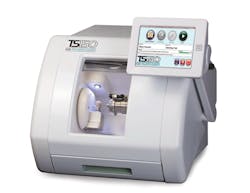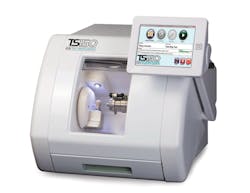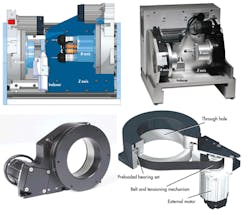Bell-Everman Rotary Stages Usher in Chair-Side Dental Crowns
“Chair-side” milling machines can now make ceramic dental crowns in a couple hours, thanks to dentist-friendly CAD/CAM software and rotary stages.
The new equipment contrasts with traditional restorations, where dentists make physical impressions, send them to special facilities, and may get a crown back in days.
The digital dentistry system comes from IOS Technologies Inc., San Diego. It includes Fastscan, an intraoral scanner, which creates high- resolution digital impressions that are significantly more accurate than traditional impressions. CAD software called FastDesign guides dentists through the scanning process and proposes ideal custom restorations. It then generates CAM instructions, which are carried out on the milling subsystem, dubbed the TS150.
Rather than executing Cartesian motion — where linear X and Y axes position cutting tools — the TS150 uses rotary motion and polar positioning coordinates. In so doing, it surpasses the precision and accuracy levels of digital dentistry systems costing 40% more, says IOS. The polar motion system can be applied to nondental applications such as CNC micromachining and subtractive prototyping.
The chair-side mill employs a pair of Bell-Everman Inc., Goleta, Calif., ServoBelt rotary stages installed vertically and facing one another. One stage positions the workpiece, a ceramic blank machined into the finished crown. The other stage positions an air spindle with the cutting tool. The stage with the cutting tool also moves axially toward the other stage on a short-travel Bell-Everman ServoNut linear drive, which forms the Z axis. A small indexing workholder rotates the blank 180° about its vertical axis during machining so it can be shaped on two sides.
The algorithms controlling rotation of the two stages relative to one another use polar coordinates. One difficulty is that the IOS scanner and software puts 3D imaging data in an STL file, and the system references points on the crown surface in Cartesian space. So the controller must transform this data into polar coordinates to generate toolpaths for the rotary stages. The Delta Tau Turbo PMAC can handle this job because it supports polar kinematics and has the processing power to transform the coordinates in real time.
The belt-driven ServoBelt rotary stages eliminate bearing rumble, which can affect linear-motion devices that use recirculating balls or other rolling elements. With the dental mill, rumble was a deal breaker because it can read through to the surface finish of the crown. The rotary stages each contain beefy, 6-in.-diameter duplex angular contact bearings that are far stiffer than the linear bearings used in a Cartesian system with the same envelope. Rotary bearings with high dynamic stiffness let the milling machine resist chatter even at high feed rates and spindle speeds as high as 150,000 rpm.
Machining ceramic crowns requires liberal amounts of cutting fluid, so the entire work of the machine is sealed. But just two simple seals, one for each axis, protect the motion system. IOS personnel report the ease of sealing the rotary stages helped keep costs down.
Similarly, rotary stages don’t always have lower price tags than linear systems. But IOS says it would have taken top-shelf linear-motion components to get the kind of speed, smoothness, and accuracy the rotary stages provide. The TS150 sells for about 40% less than comparable machines and can finish a crown in about 15 min while holding tolerances within 30 μm. IOS says typical tolerances in the industry are 50 μm, but the additional accuracy delivered by the chair-side dental mill improves the fit of the crown.
About the Author
Leland Teschler
Lee Teschler served as Editor-in-Chief of Machine Design until 2014. He holds a B.S. Engineering from the University of Michigan; a B.S. Electrical Engineering from the University of Michigan; and an MBA from Cleveland State University. Prior to joining Penton, Lee worked as a Communications design engineer for the U.S. Government.


